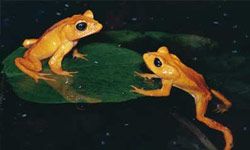Amphibians are a class of the animal kingdom that includes toads, frogs and newts. The word amphibian comes from the Greek word meaning, "a being with a double life." Amphibians are so called because they have two stages of development -- the larval stage and the adult stage. For example, tadpoles are the larval stage of frogs. Most amphibians also live both in and out of the water, although some amphibians live only in water and some only on land [source: St. Louis Zoo]. These creatures are fascinating animals with distinct features and unique characteristics. Read the tips listed below and learn about how to identify the amphibians in your region.
- Appearance The most distinguishing characteristic of different amphibians is their appearance. Frogs have long, muscular legs and smooth skin. Depending on the species, they may have markings on their skin, such as stripes or spots. They also have marks behind their eyes covering their eardrums. Toads, on the other hand, have shorter legs. Their skin is rough and covered in warts. While their color may vary between brown, green or red, they tend to have fewer markings on their skin. Newts, though also amphibians, look more like lizards. They have long bodies with short legs. Their skin texture, color and markings differ significantly amongst the species [source: BBC].
- Movements Different species of amphibians move in different ways, providing key clues to tell you whether you're in the presence of a toad or a frog. If you disrupt an amphibian in its natural surroundings and it hops away, you know that you just saw a frog. Frogs hop from place to place while toads crawl. Also, when you disrupt a toad, it tends to stay still, rather than fleeing [source: ARC].
- Spawn The appearance of amphibian spawn differs greatly between the species. If you find roe near a pond, you can easily identify which amphibians will grow from the eggs. Frog spawn grow in clumps, often near a source of water. Toads spawn in strings with rows of eggs in lines. Interestingly, newts wrap each of their eggs in an individual leaf [source: BBC].
Advertisement
